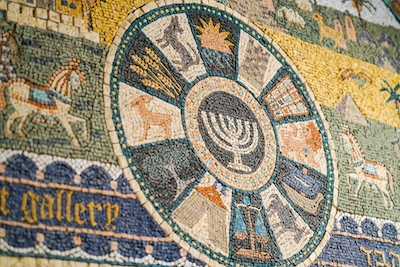Question: Why are Jewish marriage contracts written in Aramaic instead of Hebrew?
According to the Talmud, one of the legal avenues through which to affect a marriage is a shtar — a written contract. This is the reason that Jewish weddings today feature a ketubah, a Jewish marriage marriage contract, the earliest surviving one of which dates back to 440 CE. It was written in Aramaic.
Then, like now, not everyone in the Jewish community spoke or understood Hebrew. We see this clearly in a mishnah (Megillah 4:4), which states: “One who reads from the Torah should not read fewer than three verses. And (when it is being translated), he should not read to the translator more than one verse at a time.” The figure of the translator, who interpreted the Torah as it was being read in synagogue, was needed to make sure the teachings were understood by everyone in attendance.
In talmudic times, Aramaic was the lingua franca of the Jewish people. It was the vernacular in which Jews spoke, conducted business, and understood texts. And at a time when literacy and printed materials were both in short supply, it was a lot to ask people to learn another language for their spiritual lives.

Help us keep Jewish knowledge accessible to millions of people around the world.
Your donation to My Jewish Learning fuels endless journeys of Jewish discovery. With your help, My Jewish Learning can continue to provide nonstop opportunities for learning, connection and growth.
It is in this milieu that the ketubah as we know it came into being. Today, we often think of the ketubah as a meaningful statement of marital values, or as a significant piece of art, but it is fundamentally a contract, a legal document that sets out the terms of the marriage. As such, it needed to be understood — and ideally not through a translator. Like other business documents of the time, it was written in Aramaic so its signers understood the terms, literally and figuratively. Because it’s not a sacred text, it was not written in Hebrew, the holy language which was then reserved only for texts deemed sacred or canonical — not for the work of everyday life.
By this logic, we would expect modern day ketubot in the United States to be written in English, since there are not a lot of Aramaic speakers floating around anymore. But in an almost inverse logic, many (if not most) couples today use an Aramaic ketubah precisely because it is not English (though many also feature an English translation). Unlike in talmudic times, we use Aramaic today precisely to set the ketubah apart from other business documents. In doing so, we elevate the status of the ketubah, making it a part of our spiritual lives.

Rabbi Sari Laufer is the chief engagement officer at Stephen Wise Temple in Los Angeles.



